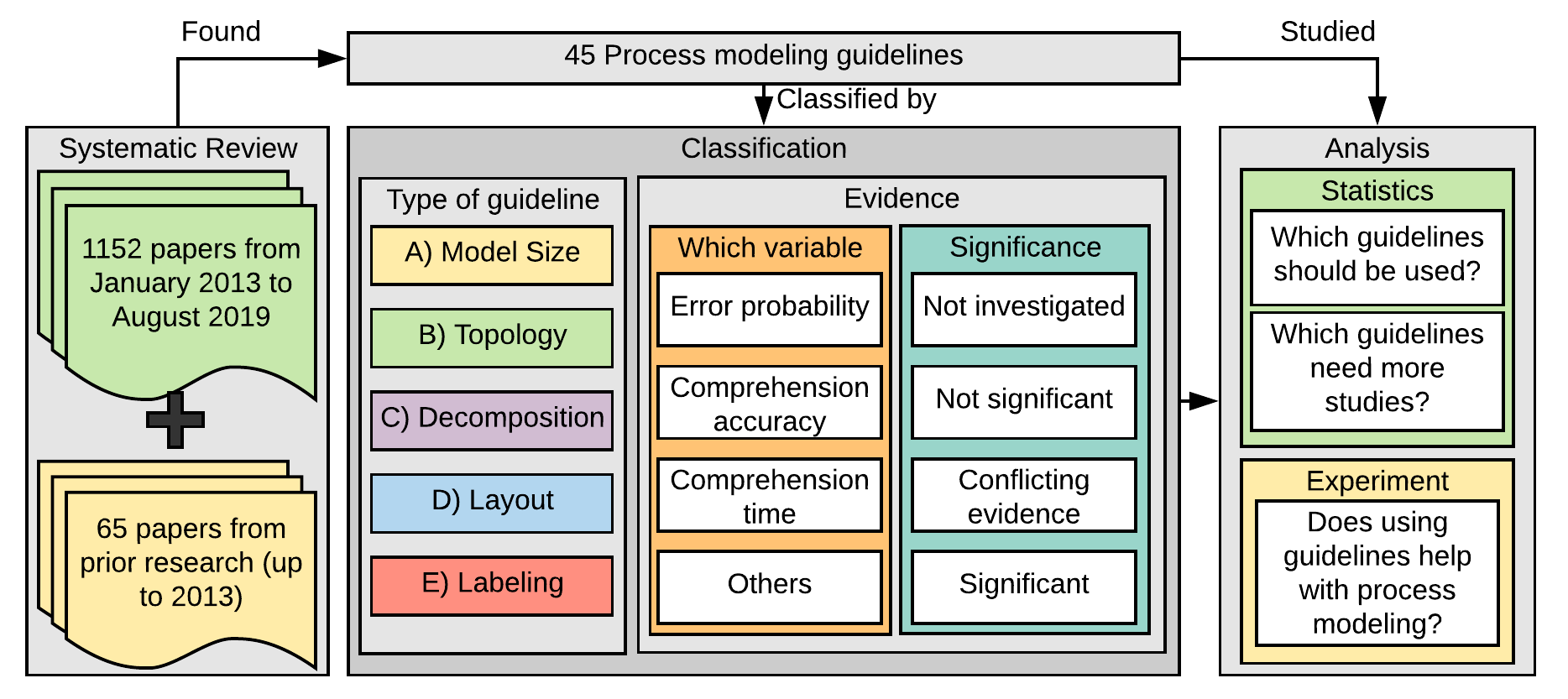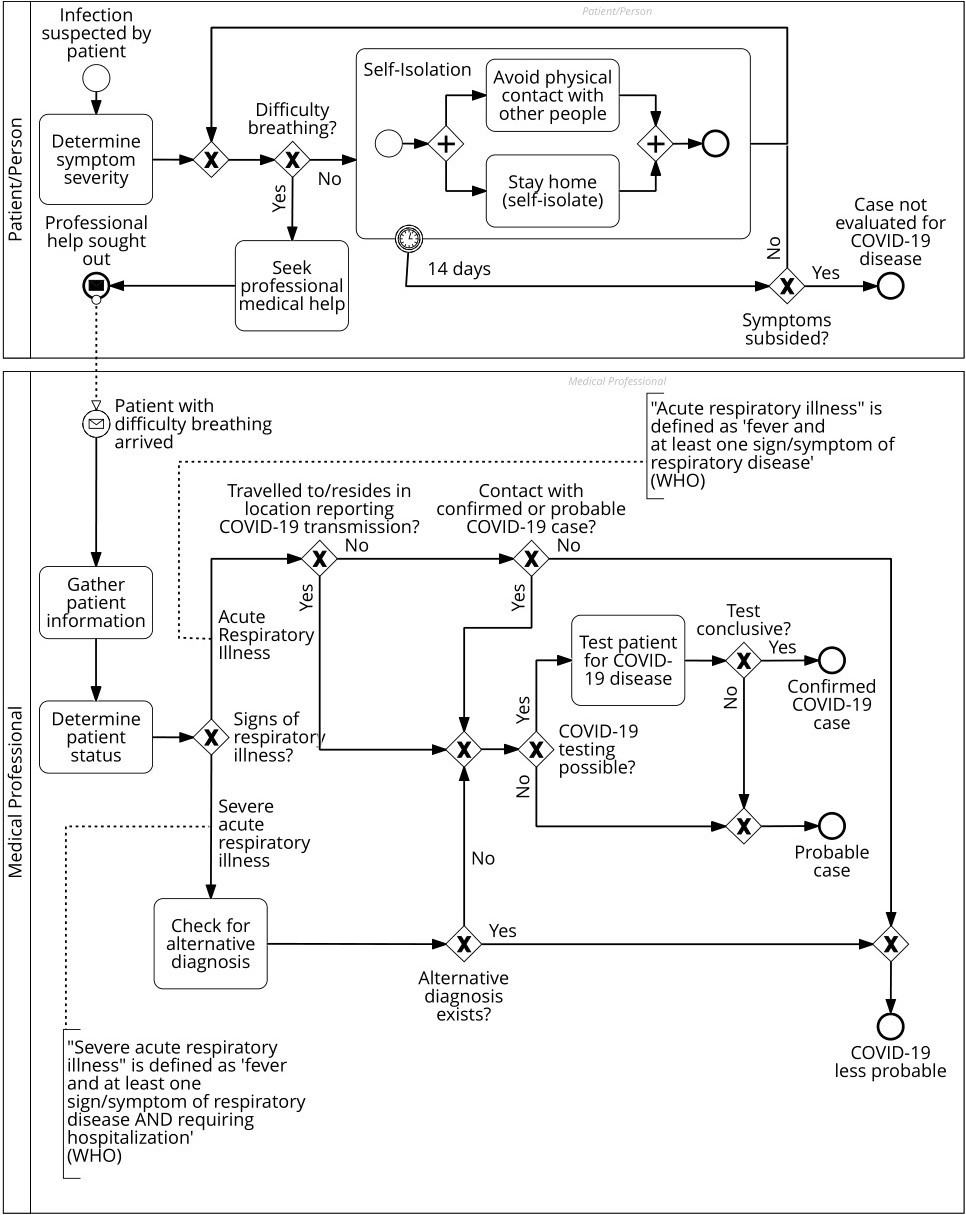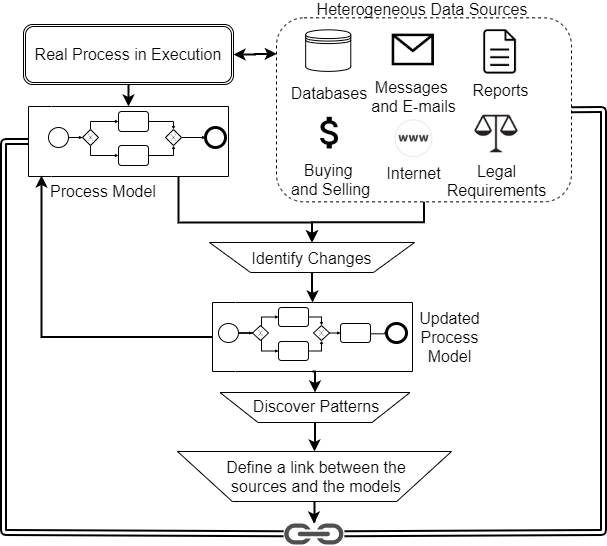My main research interests include the following topics in the area of Business Process Management (BPM):
- Process model extraction from natural language text
- Process model quality
- Process implementation and process visualization
- Healthcare process
- Process adaptation, Process Mining, Robotic Process Automation (RPA)
- Education in BPM
- Gender Influence in BPM
- Green BPM
- Artificial Intelligence (AI) and Generative AI in BPM
Process model extraction from natural language text
Organizational documents can be a valuable source of information for designing process models. However, not always do the documents include structured data to be processed by tools that extract process models from natural language text. In this context, our goal in this research line is to preprocessing the natural language text, to have a process description that is more structured, with less ambiguity, and that allows identifying process model elements in natural language text.
Sample of Publications
- Jan Mendling, Henrik Leopold, Lucinéia Heloisa Thom, Han van der Aa. Natural Language Processing with Process Models (NLP4RE Report Paper). REFSQ Workshops in 2019.
- Thanner Soares Silva, Diego Toralles Avila, Jean Ampos Flesch, Sarajane Marques Peres, Jan Mendling, Lucinéia Heloisa Thom. A Service-Oriented Architecture for Generating Sound Process Descriptions. EDOC 2019: 1-10.Renato César Borges Ferreira, Thanner Soares Silva, Diego Toralles Avila, Lucinéia Heloisa Thom, Marcelo Fantinato. Recognition of Business Process Elements in Natural Language Texts. ICEIS (Revised Selected Papers) 2017: 591-610.
- Thanner Soares Silva, Lucinéia Heloisa Thom, Aline Weber, José Palazzo Moreira de Oliveira, Marcelo Fantinato. Empirical Analysis of Sentence Templates and Ambiguity Issues for Business Process Descriptions.OTM Conferences (1) 2018: 279-297.
- Renato César Borges Ferreira, Lucinéia Heloisa Thom, Marcelo Fantinato. A Semi-automatic Approach to Identify Business Process Elements in Natural Language Texts. ICEIS (3) 2017: 250-261.
- Renato César Borges Ferreira, Lucinéia Heloisa Thom, José Palazzo Moreira de Oliveira, Diego Toralles Avila, Rubens Ideron dos Santos, Marcelo Fantinato. Assisting Process Modeling by Identifying Business Process Elements in Natural Language Texts.ER Workshops 2017: 154-163.
- Ana Cláudia de Almeida Bordignon, Lucinéia Heloisa Thom, Thanner Soares Silva, Vinicius Stein Dani, Marcelo Fantinato, Renato César Borges Ferreira. Natural Language Processing in Business Process Identification and Modeling: A Systematic Literature Review.SBSI 2018: 25:1-25:8.
Sample of Process model quality
Process models help its readers to acquire a higher comprehension of a process, allowing for the discovery of opportunities for its improvement. However, the comprehension of a process model is not guaranteed, as process modeling is a complex task that depends on the proficiency of the process modeler to avoid the creation of badly designed constructs. Process modeling guidelines are an essential tool in this regard, though they are dispersed across the many studies of the literature and not all of them have empirical evidence validating their effects. Our goal of this research line is to collect and analyze the modeling guidelines found in the literature in a systematic way.
Methodology to develop a systematic review of process modeling guidelines
Sample of Publications
- Diego Toralles Avila, Rubens Santos, Jan Mendling, Lucineia Heloisa Thom, A systematic literature review of process modeling guidelines and their empirical support. Business Process Management Journal, 2020. DOI: 10.1108/BPMJ-10-2019-0407
- Diego Toralles Avila, Raphael Piegas Cigana, Marcelo Fantinato, Hajo A. Reijers, Jan Mendling, Lucinéia Heloisa Thom. An Experiment to Analyze the Use of Process Modeling Guidelines to Create High-Quality Process Models. DEXA (2) 2019: 129-139.
- Valter Helmuth Goldberg Júnior, Vinicius Stein Dani, Diego Toralles Avila, Lucinéia Heloisa Thom, José Palazzo Moreira de Oliveira, Marcelo Fantinato. An Interface Prototype Proposal to a Semiautomatic Process Model Verification Method Based on Process Modeling Guidelines.ICEIS (Revised Selected Papers) 2017: 611-629.
- Valter Helmuth Goldberg Júnior, Lucinéia Heloisa Thom, José Palazzo Moreira de Oliveira, Marcelo Fantinato, Diego Toralles Avila. A Semiautomatic Process Model Verification Method based on Process Modeling Guidelines.ICEIS (3) 2017: 274-281.
Sample of Process implementation and process visualization
A process model at a conceptual level must be transformed into an executable process model in order to be supported by a Business Process Management System (BPMS). However, not all BPMN elements used in a process model are supported by existent BPMS. On the other hand, process modeling tools do not always show process modeling errors in a proper way. So, the process designer must be very expert to identify such errors. Following these issues, in this research line, we investigate existent BPMSs and their support to BPMN elements. 
Methodology to analyze the support of BPMN 2.0 elements in BPMS (Details in C. Habekost dos Santos ; L. H. Thom., E. Cota, M. Fantinato. Supporting BPMN tool developers through meta-algorithms)
This research line also investigates how BPMN existing modeling tools help users in achieving process models with fewer modeling problems. In this context, we have developed a systematic literature review on the visualization of business process models.
The methodology of our systematic literature review on the visualization of business process models (Details in: V. S. Dani, C. M. Dal Sasso Freitas, L. H. Thom. Ten years of visualization of business process models: A systematic literature review)
Finally, in this research line, we investigate if an organization has the necessary resources to implement its process models. This approach helps to avoid unnecessary effort, in case an organization does not have the necessary resources to implement a process model.
Sample of Publications
- Leonardo Silva Rosa, Thanner Soares Silva, Marcelo Fantinato, Lucinéia Heloisa Thom: A visual approach for identification and annotation of business process elements in process descriptions. Comput. Stand. Interfaces 81: 103601 (2022).
Carlos Habekost dos Santos ; Lucinéia Heloisa Thom. Erika Cota, Marcelo Fantinato. Supporting BPMN tool developers through meta-algorithms. International Journal of Business Information Systems (Print), v. 32, p. 460-488, 2019. - Vinicius Stein Dani, Carla Maria Dal Sasso Freitas, Lucinéia Heloisa Thom. Ten years of visualization of business process models: A systematic literature review.Comput. Stand. Interfaces 66 (2019).
- Clemilson Luís de Brito Dias, Vinicius Stein Dani, Jan Mendling, Lucinéia Heloisa Thom. Anti-patterns for Process Modeling Problems: An Analysis of BPMN 2.0-Based Tools Behavior.Business Process Management Workshops 2019: 745-757.
- Miller Biazus, Carlos Habekost dos Santos, Larissa Narumi Takeda, José Palazzo Moreira de Oliveira, Marcelo Fantinato, Jan Mendling, Lucinéia Heloisa Thom. Software Resource Recommendation for Process Execution Based on the Organization’s Profile.DEXA (2) 2019: 118-128.
- Carlos Habekost dos Santos, Lucinéia Heloisa Thom, Marcelo Fantinato. Investigating Completeness of Coding in Business Process Model and Notation.ICEIS (3) 2015: 328-333.
Sample of Healthcare process
Healthcare processes are characterized by frequent changes, numerous exceptions, and complex deviations from the norm. Despite the increasing adoption of process-aware healthcare information systems (PAHIS), there still exist numerous issues related to the handling of exceptions in clinical processes that are not effectively supported in contemporary PAHIS. The goal of this research line is to get a deeper understanding of clinical work practices and to better understand how IT process support should look like for them. In particular, we are currently investigating the most used Triage Protocols in hospitals, and emergency care unities in South Latin American. In addition, we design these protocols with BPMN. Our goal is to assist healthcare professionals in the understanding and use of triage protocols. Besides that, we aim at documenting from a behavioral and graphical perspective of the healthcare process, such as the Identification Process of Covid-19.
Sample of Publications
- Bohnenberger, Nicolas Mauro de Moreira , Schmitt, Alessandra Ceolin and Thom, Lucinéia Heloisa. (2021). Discovering Healthcare Processes from Natural Language Documents: a case study on COVID-19. PACIS Conference.
- Thom, Lucineia and Reichert, Manfred and Iochpe, Cirano and de Oliveira, Jose Palazzo M. (2010). Why Rigid Process Management Technology Hampers Computerized Support of Healthcare Processes. In: X Workshop on Medical Informatics (WIM’2010), Workshop held in conjunction with SBC’10 Congress, Belo Horizonte, Brazil, pp. 1522-1531.
- Design of the human-to-human transmission and contagion processes of SARS-CoV-2 and the symptomatic manifestation and identification processes of COVID-19 – Preprint at the ResearchGate
Process adaptation, process mining and RPA
Keeping conceptual process models up to date is a challenge. Not always conceptual process models are immediately transformed into executable models and with time they can become not updated. In this research line, we are developing an approach to keep conceptual process models updated. The approach will be based on heterogeneous sources and process mining.
Methodology to keep conceptual process models (real process) up to date
This research line also comprises a systematic review of how BPM educators are teaching the BPM discipline. We start with a systematic literature review and in a second step, we will use process mining to identify educational standards.
Education in BPM
Education in BPM is a very important topic that still poses many challenges. Research questions on this topic include:
- Which are the best methodologies to teach BPM?
- Which books teach BPM in an academic + practical format?
- How should a BPM academic curriculum be structured?
- Which Universities include BPM as a discipline (subject) or as an entire course?
- Is there any teaching emphasis on BPM topics?
In my research group, I have been encouraging the work on these topics. Our first contribution is as follows.
| Silva, Diogo; Thom, Lucineia Heloisa. 3D environment approach to teaching and learning business process management concepts: a systematic literature review. Simpósio Brasileiro de Informática na Educação (SBIE). 2021. Abstract. Although efficient process management is a factor that impacts the competitiveness of organizations, undergraduate students entering the employment market still have difficulties understanding and performing functions related to BPM, which indicates obstacles in teaching and learning these concepts. Using innovative approaches such as 3D environments can bring pedagogical resources to complement BPM training. This work performs a systematic literature review to investigate approaches using 3D environments in BPM courses and training to find their impact on learning and teaching. Studies suggest that 3D environments can positively affect the BPM teaching and learning process and impact student motivation, keeping them connected to the study material. |